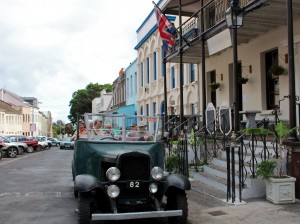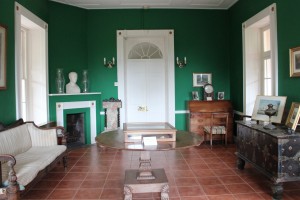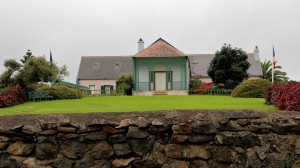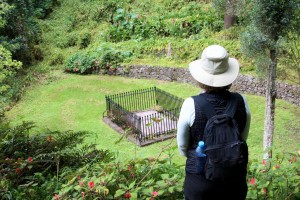 To get the lay of the land, I decided to see St Helena’s historical sites first as a pure tourist, joining a group of my fellow shipmates for the Napoleonic tour in a modified 1929 Chevrolet. The engine whined as the car clung to steep hillsides on twisty one-lane roads, the driver honking at each blind turn. In British St Helena, they drive on the left, but most roads are so narrow they require the downhill car to pull aside to yield to the uphill vehicle.
To get the lay of the land, I decided to see St Helena’s historical sites first as a pure tourist, joining a group of my fellow shipmates for the Napoleonic tour in a modified 1929 Chevrolet. The engine whined as the car clung to steep hillsides on twisty one-lane roads, the driver honking at each blind turn. In British St Helena, they drive on the left, but most roads are so narrow they require the downhill car to pull aside to yield to the uphill vehicle.
We visited the three Napoleonic sites: the Briars, where Napoleon stayed when he first arrived on the island; Longwood House, where he spent the remaining five and a half years of his life; and the Valley of the Tomb, where he was buried. They are what I traveled eleven thousand miles to see. I will visit all three sites again on my own and I’ll discuss each in more depth in multiple blog entries, but here for you (as on my first day in St Helena) is a quick overview.
 Until a fast British sloop arrived four days before the rest of the squadron carrying the exiled emperor, little St Helena had no idea it was going to host Napoleon’s incarceration. Local officials scrambled to find a facility suitable for the man who was both a slippery Monster and a legitimate sovereign. They settled on Longwood House, once a stable, then the lieutenant governor’s summer house. It needed work, and when he saw it, Napoleon wasn’t pleased, but on the way back to Jamestown, he came across the Briars, a pleasant house in a verdant valley. He asked to speak to its owners, the Balcombe family. Recovering from their surprise, they invited him to stay with them until Longwood was appropriately outfitted. Napoleon remembered his nine weeks there as his happiest on St Helena.
Until a fast British sloop arrived four days before the rest of the squadron carrying the exiled emperor, little St Helena had no idea it was going to host Napoleon’s incarceration. Local officials scrambled to find a facility suitable for the man who was both a slippery Monster and a legitimate sovereign. They settled on Longwood House, once a stable, then the lieutenant governor’s summer house. It needed work, and when he saw it, Napoleon wasn’t pleased, but on the way back to Jamestown, he came across the Briars, a pleasant house in a verdant valley. He asked to speak to its owners, the Balcombe family. Recovering from their surprise, they invited him to stay with them until Longwood was appropriately outfitted. Napoleon remembered his nine weeks there as his happiest on St Helena.
 As Napoleon’s residence for five and a half years and the site of his death, Longwood House is the most significant site on the island. It’s also the most interesting to me because an important part of my novel takes place there during the last days of Napoleon’s life. Let’s face it: as a novelist, I want to hear from the ghosts. That’s why I’ve pre-arranged to come back here and visit its rooms totally alone.
As Napoleon’s residence for five and a half years and the site of his death, Longwood House is the most significant site on the island. It’s also the most interesting to me because an important part of my novel takes place there during the last days of Napoleon’s life. Let’s face it: as a novelist, I want to hear from the ghosts. That’s why I’ve pre-arranged to come back here and visit its rooms totally alone.
 When Napoleon died on May 5, 1821, he asked for his ashes (in French, ashes is a general term for a dead body, whether cremated or not) to reside along the Seine among the French people whom he had loved so well. That wasn’t going to happen with his enemies, the Bourbon royalty, back in power so he was buried in his second choice, the Valley of the Geranium of St Helena, coincidentally called, the Sane Valley.
When Napoleon died on May 5, 1821, he asked for his ashes (in French, ashes is a general term for a dead body, whether cremated or not) to reside along the Seine among the French people whom he had loved so well. That wasn’t going to happen with his enemies, the Bourbon royalty, back in power so he was buried in his second choice, the Valley of the Geranium of St Helena, coincidentally called, the Sane Valley.
That’s the overview: a few facts and not a lot of emotion. I need time to digest it all.

Margaret,
Following your blog is one of the most educational and pleasant vicarious experiences of my life. I feel like I’m on the trip with you except without the jet lag.
Continue to enjoy your journey.
Love, -paul
Those hillside roads sound nail-biting! 😮
And first impressions are what they are. Thank you for sharing your first-found information. It will be, like any research – 11,000 miles (!), or off a bookshelf – the basis of all that shall come. (I know more know about the differences between foil, epee, sabre, small sword, short sword, rapier, bastard sword and broad sword, and the various parrying daggers and their respective uses than I had before, for instance – no emotion yet in that either. Mwahaha! There will be though!) Tools for the writer, facts.
Looking forward to what else you pick up. 🙂
You have certainly piqued my curiosity about Napoleon. The facts are pretty darn fascinating. I hope the ghosts are very informative.
Thank you for sharing. I look forward to reading more and more and more!
Glad you’re enjoying the blog, Paul. Every day since we arrived in South Africa has been so interesting that we never had time for jet lag. In fact, each day is so full that it’s been hard to choose between spending my time having new experiences or writing about the ones I’ve already had.
Yes, Melanie, one of the best aspects of writing is how much you have to learn to write about any subject credibly, but that’s half the fun, too, isn’t it? Napoleon had such a full, complex life that I’m constantly checking the facts I think I know even as I’m absorbing new information every day. I’m looking forward to getting back to the writing grindstone and applying all I’ve learned on this trip.
Thanks, Helen. Surely Napoleon’s ghost is here on St Helena, if it’s anywhere, or perhaps, I brought him with me to revisit this fascinating place. It doesn’t really matter, as long as I, as a writer, can recreate what it felt like to be him right here back then. Glad you’re interested!
Pingback: Napoleon on Camelback in the Musée Fesch - Margaret Rodenberg
Pingback: FINDING NAPOLEON - Margaret Rodenberg
Very nice.
I am reading Finding Napoleon. I am liking it a lot.
Tk you for your hard work. I’ll bet you had lots of fun writing it.
Stephen, thank you for reading Finding Napoleon and your kind comments. As you said, I did have lots of fun with it. When the writing process is going well, it’s highly satisfying. Other times it can be difficult, frustrating, and emotionally draining. The research aspect is always fun since Napoleonic times are fascinating. I’m so glad you are enjoying Finding Napoleon! Margaret